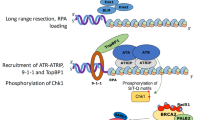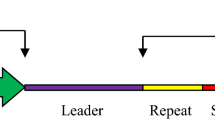Abstract
DNA double-strand breaks (DSBs) and locally multiply damaged sites (LMDS) induced by ionizing radiation (IR) are considered to be very genotoxic in mammalian cells. LMDS consist of two or more clustered DNA lesions including oxidative damage locally formed within one or two helical turns by single radiation tracks following local energy deposition. They are thought to be frequently induced by IR but not by normal oxidative metabolism. In mammalian cells, LMDS are detected after specific enzymatic treatments transforming these lesions into additional DSBs that can be revealed by pulsed-field gel electrophoresis (PFGE). Here, we studied radiation-induced DSBs and LMDS in Chinese hamster ovary cells (CHO-K1). After addition of the iron chelator deferoxamine (DFO) or the antioxidant glutathione (GSH) to the cell lysis solution, we observed reduced spontaneous DNA fragmentation and a clear dose-dependent increase of radiation-induced DSBs. LMDS induction, however, was close to background levels, independently of dose, dose rate, temperature and radiation quality (low and high LET). Under these experimental conditions, artefactual oxidative DNA damage during cell lysis could not anymore be confounded with LMDS. We thus show that radiation-induced LMDS composed of oxidized purines or pyrimidines are much less frequent than hitherto reported, and suggest that they may be of minor importance in the radiation response than DSBs. We speculate that complex DSBs with oxidized ends may constitute the main part of radiation-induced clustered lesions. However, this needs further studies.







Similar content being viewed by others
References
Ward JF (1988) DNA damage produced by ionizing radiation in mammalian cells: identities, mechanisms of formation, and reparability. Prog Nucleic Acid Res Mol Biol 35:95–125
Bennett PV, Cuomo NL, Paul S, Tafrov ST, Sutherland BM (2005) Endogenous DNA damage clusters in human skin, 3-D model, and cultured skin cells. Free Radic Biol Med 39:832–839
Goodhead DT (1994) Initial events in the cellular effects of ionizing radiations: clustered damage in DNA. Int J Radiat Biol 65:7–17
Nikjoo H, O’Neill P, Terrissol M, Goodhead DT (1999) Quantitative modelling of DNA damage using Monte Carlo track structure method. Radiat Environ Biophys 38:31–38
Nikjoo H, O’Neill P, Wilson WE, Goodhead DT (2001) Computational approach for determining the spectrum of DNA damage induced by ionizing radiation. Radiat Res 156:577–583
Sutherland BM, Bennett PV, Sidorkina O, Laval J (2000a) Clustered DNA damages induced in isolated DNA and in human cells by low doses of ionizing radiation. Proc Natl Acad Sci USA 97:103–108
Sutherland BM, Bennett PV, Sidorkina O, Laval J (2000b) Clustered damages and total lesions induced in DNA by ionizing radiation: oxidized bases and strand breaks. Biochemistry 39:8026–8031
Sutherland BM, Bennett PV, Sutherland JC, Laval J (2002) Clustered DNA damages induced by X rays in human cells. Radiat Res 157:611–616
Gulston M, Fulford J, Jenner T, Lara CD, O’Neill P (2002) Clustered DNA damage induced by gamma radiation in human fibroblasts (HF19), hamster (V79–4) cells and plasmid DNA is revealed as Fpg and Nth sensitive sites. Nucleic Acids Res 30:3464–3472
Blaisdell JO, Wallace SS (2001) Abortive base-excision repair of radiation-induced clustered DNA lesions in Escherichia coli. Proc Natl Acad Sci USA 98:7426–7430
Pearson CG, Shikazono N, Thacker J, O’Neill P (2004) Enhanced mutagenic potential of 8-oxo−7,8-dihydroguanine when present within a clustered DNA damage site. Nucleic Acids Res 32:263–270
Eot-Houllier G, Eon-Marchais S, Gasparutto D, Sage E (2005) Processing of a complex multiply damaged DNA site by human cell extracts and purified repair proteins. Nucleic Acids Res 33:260–271
Yang N, Chaudhry MA, Wallace SS (2006) Base excision repair by hNTH1 and hOGG1: a two edged sword in the processing of DNA damage in gamma-irradiated human cells. DNA Repair (Amst) 5:43–51
Cadet J, D’Ham C, Douki T, Pouget JP, Ravanat JL, Sauvaigo S (1998) Facts and artifacts in the measurement of oxidative base damage to DNA. Free Radic Res 29:541–550
Cadet J, Bourdat AG, D’Ham C, Duarte V, Gasparutto D, Romieu A, Ravanat JL (2000) Oxidative base damage to DNA: specificity of base excision repair enzymes. Mutat Res 462:121–128
Cadet J, Douki T, Frelon S, Sauvaigo S, Pouget JP, Ravanat JL (2002) Assessment of oxidative base damage to isolated and cellular DNA by HPLC–MS/MS measurement. Free Radic Biol Med 33:441–449
ESCODD (2002) Comparative analysis of baseline 8-oxo-7,8-dihydroguanine in mammalian cell DNA, by different methods in different laboratories: an approach to consensus. Carcinogenesis 23:2129–2133
Dhermain F, Dardalhon M, Queinnec E, Averbeck D (1995) Induction of double-strand breaks in Chinese hamster ovary cells at two different dose rates of gamma-irradiation. Mutat Res 336:161–167
Gunderson K, Chu G (1991) Pulsed-field gel electrophoresis of megabase-sized DNA. Mol Cell Biol 11:3348–3354
Henle ES, Luo Y, Linn S (1996) Fe2+, Fe3+, and oxygen react with DNA-derived radicals formed during iron-mediated Fenton reactions. Biochemistry 35:12212–12219
Sies H (1999) Glutathione and its role in cellular functions. Free Radic Biol Med 27:916–921
Thomas JA, Poland B, Honzatko R (1995) Protein sulfhydryls and their role in the antioxidant function of protein S-thiolation. Arch Biochem Biophys 319:1–9
Pouget JP, Douki T, Richard MJ, Cadet J (2000) DNA damage induced in cells by gamma and UVA radiation as measured by HPLC/GC–MS and HPLC–EC and Comet assay. Chem Res Toxicol 13:541–549
Pouget JP, Ravanat JL, Douki T, Richard MJ, Cadet J (1999) Measurement of DNA base damage in cells exposed to low doses of gamma-radiation : comparison between the HPLC–EC and Comet assay. Int J Radiat Biol 75:51–58
Blöcher D, Einspenner M, Zajackowski J (1989) CHEF electrophoresis, a sensitive technique for the determination of DNA double-strand breaks. Int J Radiat Biol 56:437–448
Burkart W, Jung T, Frasch G (1999) Damage pattern as a function of radiation quality and other factors. C R Acad Sci III 322:89–101
Pouget JP, Frelon S, Ravanat JL, Testard I, Odin F, Cadet J (2002) Formation of modified DNA bases in cells exposed either to gamma radiation or to high-LET particles. Radiat Res 157:589–595
Boucher D, Hindo J, Averbeck D (2004) Increased repair of gamma-induced DNA double-strand breaks at lower dose-rate in CHO cells. Can J Physiol Pharmacol 82:125–132
Dikomey E, Brammer I (2000) Relationship between cellular radiosensitivity and non-repaired double-strand breaks studied for different growth states, dose rates and plating conditions in a normal human fibroblast line. Int J Radiat Biol 76:773–781
Nikjoo H, O’Neill P, Goodhead DT, Terrissol M (1997) Computational modelling of low-energy electron-induced DNA damage by early physical and chemical events. Int J Radiat Biol 71:467–483
David-Cordonnier MH, Laval J, O’Neill P (2001) Recognition and kinetics for a base lesion within clustered DNA damage by the Escherichia coli proteins Fpg and Nth. Biochemistry 40:5738–5746
Kuhne M, Rothkamm K, Lobrich M (2002) Physical and biological parameters affecting DNA double strand break misrejoining in mammalian cells. Radiat Prot Dosimetry 99:129–132
Lobrich M, Cooper PK, Rydberg B (1998) Joining of correct and incorrect DNA ends at double-strand breaks produced by high-linear energy transfer radiation in human fibroblasts. Radiat Res 150:619–626
Stenerlow B, Hoglund E (2002) Rejoining of double-stranded DNA-fragments studied in different size-intervals. Int J Radiat Biol 78:1–7
Pinto M, Prise KM, Michael BD (2005) Evidence for complexity at the nanometer scale of radiation-induced DNA DSBs as a determinant of rejoining kinetics. Radiat Res 164:73–85
Lobrich M, Jeggo PA (2005) The two edges of the ATM sword: co-operation between repair and checkpoint functions. Radiother Oncol 76:112–118
Leatherbarrow EL, Harper JV, Cucinotta FA, O’Neill P (2006) Induction and quantification of gamma-H2AX foci following low and high LET-irradiation. Int J Radiat Biol 82:111–118
Stenerlow B, Karlsson KH, Cooper B, Rydberg B (2003) Measurement of prompt DNA double-strand breaks in mammalian cells without including heat-labile sites: results for cells deficient in nonhomologous end joining. Radiat Res 159:502–510
Lundin C, North M, Erixon K, Walters K, Jenssen D, Goldman AS, Helleday T (2005) Methyl methanesulfonate (MMS) produces heat-labile DNA damage but no detectable in vivo DNA double-strand breaks. Nucleic Acids Res 33:3799–3811
Acknowledgements
This work was supported by a grant from Electricité de France (EDF). The authors are grateful to Penny Jeggo (MRC Cell Mutation Unit, Falmer, Brighton, UK) for kindly providing the Chinese Hamster Ovary cell line, Serge Boiteux (CEA Fontenay-aux-Roses, France) and Murat Saparbaev (Institut Gustave Roussy, Villejuif, France) for kindly providing Fpg, Nth and Nfo enzymes. The authors are also indebted to Evelyne Sage, Michele Dardalhon and Yannick Saintigny for valuable suggestions. Didier Boucher acknowledges a doctoral grant by Centre National d’Etudes Spatiales and Commissariat à l’Energie Atomique (DSV), France.
Author information
Authors and Affiliations
Corresponding author
Rights and permissions
About this article
Cite this article
Boucher, D., Testard, I. & Averbeck, D. Low levels of clustered oxidative DNA damage induced at low and high LET irradiation in mammalian cells. Radiat Environ Biophys 45, 267–276 (2006). https://doi.org/10.1007/s00411-006-0070-3
Received:
Accepted:
Published:
Issue Date:
DOI: https://doi.org/10.1007/s00411-006-0070-3




